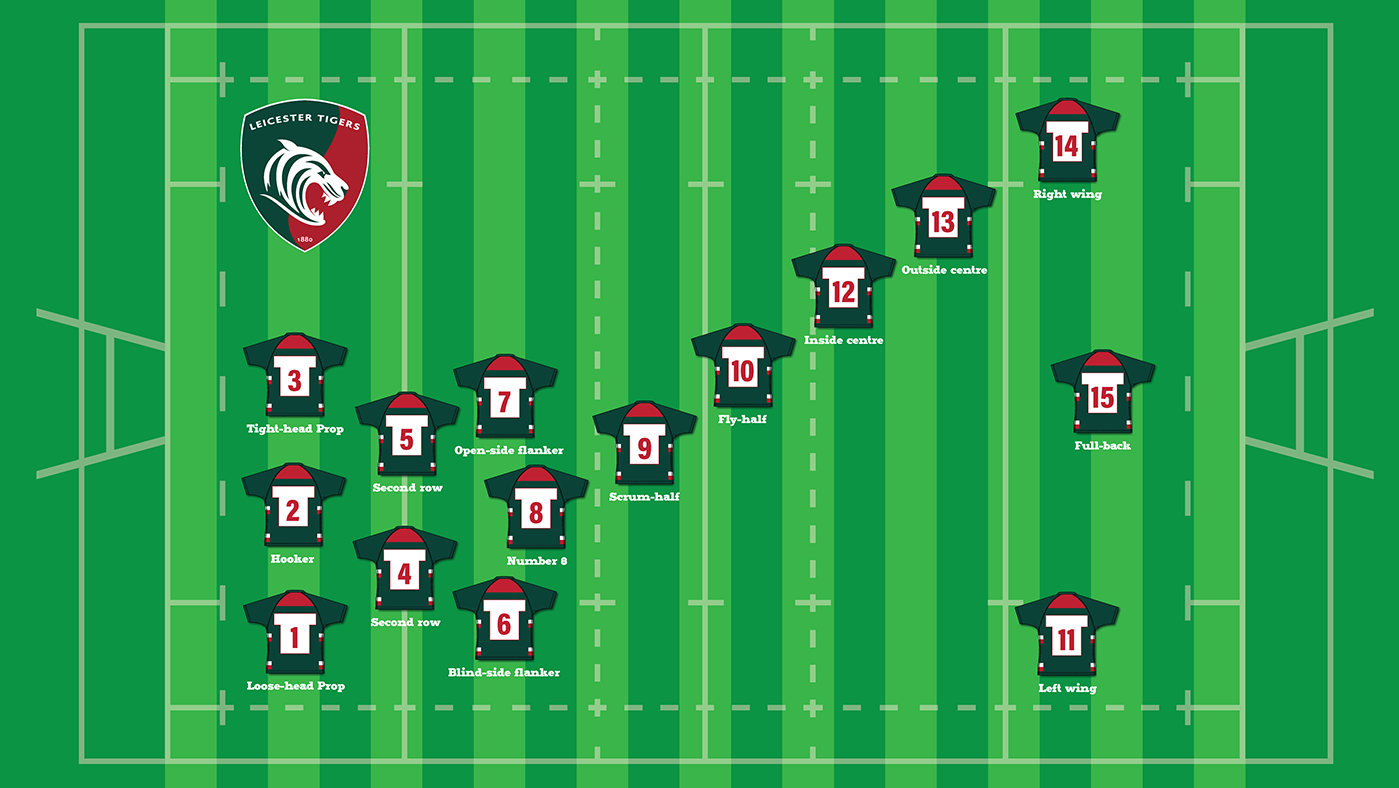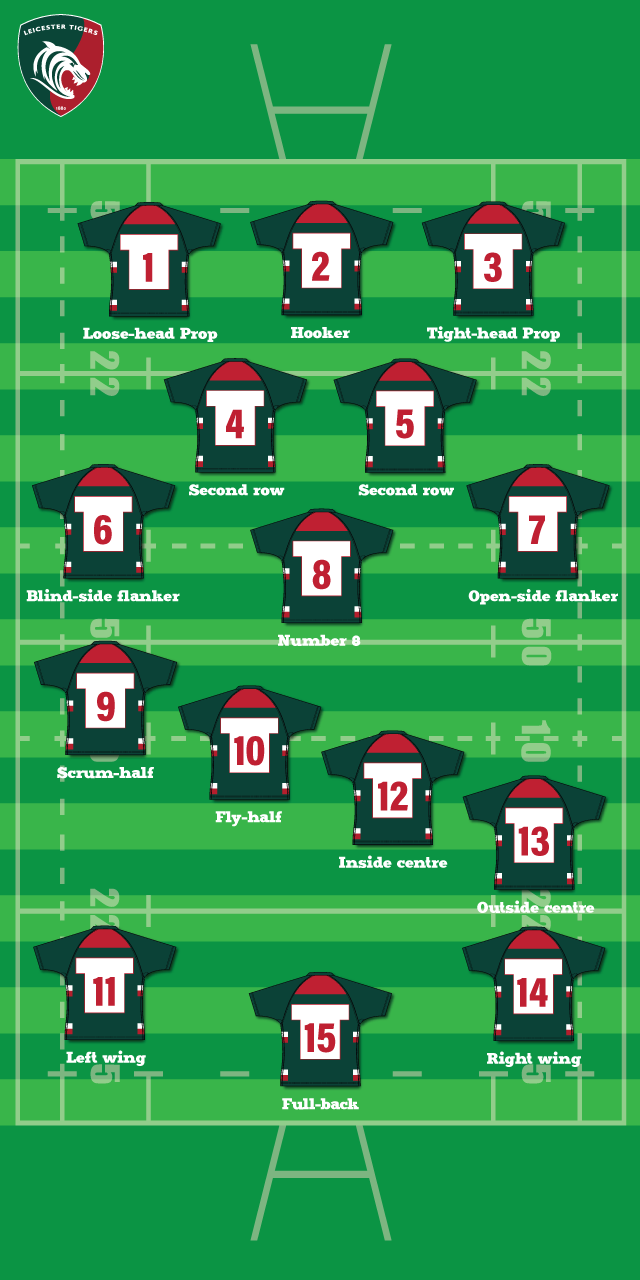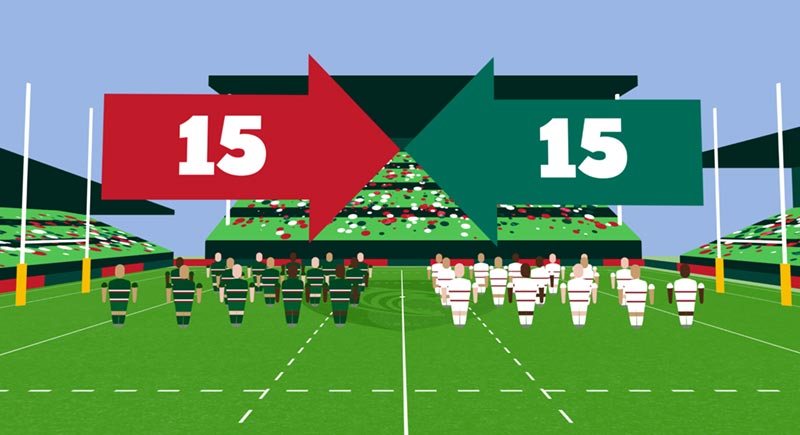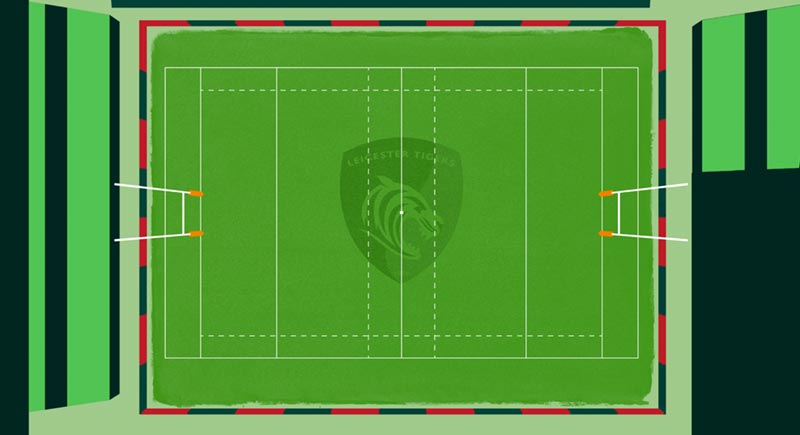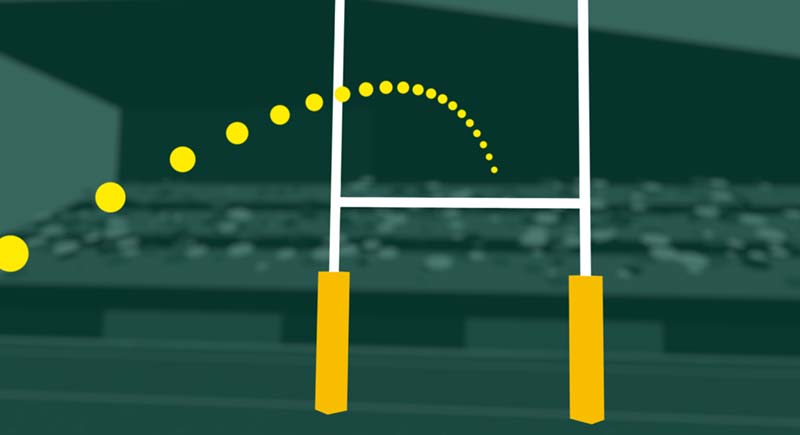Glossary
Filter by A–Z
a
ABC Club
Exclusive to Tigers, the ABC Club is also known as the front row.
Advantage
When the result of an infringement by one team is that the opposing team may gain an advantage, the referee does not whistle immediately for the infringement.
Assistant referees
Previously known as touch judges.
Attacking team
The team that is in possession of the ball.
b
Back 3
Consists of the 2 wingers and the full back
Back row
Consists of the blindside flanker, openside flanker and the No.8
Backs
The players who are not in scrum. Consists of a scrum half, fly half, 2 centres, 2 wingers and a full back
Ball carrier
The player in possession of the ball.
Bind
When each prop must use their free hand to grab on to the jersey of prop opposite them in the scrum.
Binding
Firmly grasping another player’s body between the shoulder and the hips.
Blindside
Refers to the side of the scrum which is closest to a touchline.
Blindside Flanker
Often referred to as the No.6, the blindside flanker is the flanker in the scrum who is closest to the touchline
Blood Replacement
A replacement that allows a wounded player to leave the field and be replaced by another player temporarily.
Bonus Point
An additional point is awarded following a game, if the winning team scores 4 tries or the losing team stays within 7 points of the winning team.
Box kick
A high over-the-shoulder kick used usually by the scrum-half in defensive situations or in initiating an attack.
Breakdown
Also known as a ruck, where one or more players from each team, who are on their feet, in physical contact, close around the ball on the ground.
c
Centre
There are 2 centres that line-up between the fly-half and one of the wingers
Charge Down
When a defending player blocks an attacking player’s kick. The ball may travel forward and not result in a knock on.
Citing Commissioner
A member of the Match Officials group at games, who is in charge of reporting any foul play or indiscretions and recommending for suspensions.
Conversion
Following a try, the scoring team is given the opportunity to score two more points by kicking the ball through the opposition posts. This is called a conversion.
Converted
A conversion kick that was successful
Crash Ball
When a player receives the ball at speed and runs into the opposition’s defensive line and then offload the ball to a teammate in the tackle.
Cross Kick
A diagonal kick across the pitch in order to quickly get the ball to the opposite side of the pitch to exploit space.
Crossbar
The horizontal bar between the goalposts.
Crouch
To start the scrum the referee will call ‘crouch’. This instructs the front rows from each side to crouch.
d
Dangerous Play
Any act that intentionally puts the safety of a player at harm (punching, stamping etc.)
Dead ball
The ball is out of play. Occurs when ball has gone out of the playing area.
Dead ball line
The line at either end of the pitch, which results in a dead ball once the ball travels beyond it.
Defending team
The team that is not in possession of the ball.
Drive
When the forwards combine to carry ball towards the opposition tryline.
Drop Goal
A drop kick that results in the ball going through the opposition posts results in 3 points being scored.
Drop kick
A type of kick that involves the player dropping the ball then kicking it when the ball hits the ground.
Drop out
A drop kick taken by a team behind their own 22-metre line.
Dummy
When a player with ball fakes passing the ball but instead continues to carry the ball.
e
Entertainment
It’s not just the rugby that Tigers provide. We have plenty of entertainment for you to enjoy from before pre-match to post-match.
f
Fifteen metre line
A horizontal dash line that runs parallel to the touchline. This line along with the horizontal 5 metre line creates an area in which a lineout must take place.
Five metre line (horizontal)
A horizontal dash line that runs parallel to the touchline. This line along with the 15 metre line creates an area in which a lineout must take place.
Five metre line (vertical)
The vertical 5m line runs parallel to the tryline. The game is restarted from here if an infringement takes place close to the tryline.
Flanker
Back-row forward who usually wears No.6 or No.7.
Fly-Half
Wears the No.10 and controls the flow of the game.
Forward pass
When a player passes the ball forward, i.e. toward the opposition tryline
Forwards
Consists of the front row, second row and back row, coming together as the forward pack.
Foul Play
Anything a player does that is against the Laws of Rugby.
Free Kick
Awarded to the non-offending team after minor technical infringements.
Front Row
The three forwards at the front of the scrum, consisting of a loose-head prop, a hooker and a tight-head prop
Full-back
Wears the No.15 and is the last player in defence.
g
Gainline
is an imaginary line (parallel to the halfway line) drawn across the pitch at the point where there is a breakdown in open play.
Garryowen
Also known as an Up and Under.
Gate
Refers to the area in which players must enter the ruck following a completed tackle.
Goal line
Also known as the try line, the horizontal full line under the posts at each end that marks the area in which a try can be scored.
Goal Posts
Made up of two vertical posts and a crossbar. These are the posts the ball must dissect to score kicks.
Goal-kicker
Refers to the player who kicks the penalties & conversions.
Grounding
When a player presses the ball down on the ground in the in-goal area.
Grubber
When a player intentionally kicks the ball along the ground.
h
H.I.A
Head injury assessment, which takes place for 12 minutes when a player is suspected to have been concussed on-field
Haka
A traditional Māori dance that is performed pre-game by New Zealand and other Pacific Islands.
Half-back
Another term to describe the fly-half or scrum-half
Half-time
The interval between two 40-minute halves
Halfway Line
The halfway line is used to kick-off and restart the match following a score.
Hand-off
Action taken by a ball carrier to fend off an opponent using the palm of the hand
Hat-trick
Term used when a player scores 3 tries in one game.
Heave (Heeeave)
When the Tigers have a rolling maul or scrum the Tigers Family roar Heeeave!
Held Up
When a player carrying the ball is prevented from grounding it on or over the tryline they are ‘held up’.
High tackle
When a defending player tackles an attacking player above the line of the shoulders.
Hooker
Wears the No.2 jersey, plays in the middle of the front row and hooks the ball at the scrum.
Hospital Pass
Term used to describe a pass that puts the receiver in a situation where heavy contact from the opposition is unavoidable.
i
In-goal area
The rectangle area between the try line and dead ball line.
Infringement
Refers to an action by a player the breaks one of the Laws of Rugby.
Inside Centre
Is the centre closest to the fly-half and usually wears the No.12
Interception
When a defending player catches a pass intended for an attacking player
j
Jackal
Refers to a player who has an exceptional ability to steal the ball from the opposition in a contact situation, they are usually flankers.
Jumpers
Usually locks or taller back-rowers, who are lifted in line-outs to receive the ball and/or to attempt to steal the opponents line-out throw.
k
Kick-off
How the game starts or restarts from the halfway line in the direction of the opposition try line.
Knock on
This occurs when a player losses possession of the ball and it goes forward.
l
Lifting
The act of team-mates combining to elevate a player at a lineout
Line of touch
The full lines that run the length of the pitch, signifying the edges of the playing surface.
Lineout
When a hooker throws the ball between the two lines of forwards from the touchline.
Lock
Also known as the second row, the locks usually wear the No.4 or No.5 jersey.
Loose-head Prop
The player on the left side of the front row and usually wears the No.1 jersey.
m
Mark
Can be called by a player who catches a kick behind their own 22-metre line. This results in a free kick from the spot of the mark.
Maul
When the ball carrier is held by one or more opponents and one of the attacking team’s players binds on to the ball carrier.
Metres
The universal measurement in rugby.
n
No. 1
Also Known as the Loosehead Prop
No. 2
Also Known as the Hooker
No. 3
Also Known as the Tighthead Prop
No. 4
Also Known as a Lock
No. 5
Also Known as a Lock
No. 6
Also Known as the Blindside Flanker
No. 7
Also Known as the Openside Flanker
No. 8
The forward at the back of the scrum, who is often the most skilful of the forwards.
No. 9
Also known as the Scrum-half
No. 10
Also known as the Fly-half
No. 11
Also Known as a Wing
No. 12
Also Known as the Inside Centre
No. 13
Also Known as the Outside Centre
No. 14
Also Known as a Wing
No. 15
Also Known as the Full-back
Not Straight
When the ball is not thrown down the middle at a lineout.
o
Obstruction
When a player intentionally prevents an opponent from playing the ball.
Offload
When a tackled player passes the ball as they are being tackled.
Offside
In general play a player is offside if they are in front of a team-mate who is carrying the ball, or in front of a team-mate who last played the ball. Offside means that a player is temporarily out of the game. Such players are liable to be penalised if they take part in the game.
Offside line
The imaginary line that runs horizontally from the ball-carrier across the pitch.
On the full
When the ball is kicked straight out of the playing area without touching the floor.
Openside
Refers to the side of the scrum which is furthest away from a touchline.
Openside flanker
The back-rower in the scrum is furthest away from the touchline
Outside Centre
The back between inside centre and winger, usually wears the No.13.
Overlap
A situation where the attacking team has more players than the defending team on one side of the pitch.
p
Pack
Another term used to describe the forwards
Pass
When the ball carrier throws the ball backwards to a team-mate
Peeling off
When a player leaves the lineout so they can receive a pass or retrieve a loose ball.
Penalty Kick
When the ball is kicked between the opposition’s posts after a penalty has been awarded.
Penalty try
Awarded when the defending team causes an infringement which prevents a clear try-scoring opportunity.
Phase
The time period in which the ball is in open play and between breakdowns
Place kick
Another term for penalty kick.
Placer
A player who holds the ball on the ground for a team-mate to kick, usually in windy conditions.
Playmaker
A player who dictates the play of his team, usually from No.10 or 12.
Possession
When a player is carrying the ball and has it in their control
Posts
The two vertical poles which, along with the crossbar, make up the goal-posts.
Prop
A front row player on the left or right end of the front row, they usually wear No.1 and No.3
Punt
The ball is dropped from the hands and kicked before it touches the ground.
q
Quiet Please
At Leicester Tigers we respect the kickers of both teams. Fans are expected to show respect by staying silent during their preparation and throughout their kick.
r
Receiver
The player that catches the ball at the lineout
Red Card
if a player has committed an act of serious foul play, he can be shown a red card by the referee and removed from the rest of the game.
Referee
The person responsible for enforcing the laws of rugby during a game.
Release
When a tackle has been completed, the tackler must ‘release’ the opposition player before they can compete for the ball.
Replacements
Also known as substitutes, players who join the action from the bench during the game.
Rolling maul
A maul that is moving forward and constantly shifting the point of attack.
Ruck
This is a phase of play where one or more players from each team, who are on their feet, in physical contact, close around the ball on the ground. Open play has ended.
s
Sanction
The action taken by the referee against a player who has committed an infringement.
Scrum
When the forwards from each team come together in a scrum formation so play can be restarted.
Scrum-half
Usually the No.9, the link between the forwards and the backs.
Second Row
Also known as Locks, they usually wear the No.4 or No.5 jersey
Set
Following the ‘bind’ at scrum time, the referee will call ‘set’ which indicates that the front rows are stable and may come together.
Set-piece
Another term used to describe the scrum or line-out.
Side
A situation where a player enters the ruck without coming through the ‘gate’ of the tackle.
Sin Bin
The area in which a player who has been yellow-carded must stay when serving 10 minutes off the pitch.
Strapping
The many, many rolls of tape on Tigers players to support niggling injuries and /or around the legs of line-out jumpers.
Substitutes
Players who can be used to replace the starting 15 players during the game.
t
Tackle
Occurs when a ball carrier is held by one or more opposition players and taken to ground.
Tackler
The player who has tackled the opposing player carrying the ball.
Tap
After a penalty has been awarded, the team in possession has the ability to tap the ball and restart play.
Ten metre line
A dashed line the runs parallel to the halfway line on each side. The ball must travel past this line following a restart or kick-off.
Tight 5
The front row and the second row of forwards, wearing numbers 1-5
Tight head Prop
The prop at the right of the front row and usually wears the No.3 jersey.
TMO
Television Match Official may be used by the referee to assist in determining whether points have been scored or infringements and foul play have taken place. The official consults television replays to determine decisions.
Touch
When a player or the ball hits or goes beyond the touch line, the ball is out of play.
Touch Judge
Now known as assistant referee, the official runs along the touchlines and signals when the ball or player goes into touch.
Touch Line
Also known as the line of touch, the touch line runs along the length of pitch on each side.
Try
When a player grounds the ball on or over the try-line resulting in 5 points.
Turnover
When a team concedes possession of the ball at the breakdown.
Twenty-two area
The 22 is the area between the try line and the 22 metre line. From the 22 the following can happen. The defending team can kick the ball into touch without bouncing. A dropout is taken by the defending team if the attacking team kicks the ball dead (over the deadball line). The defenders can catch the ball unchallenged from an attacking kick – this is called a mark.
Twenty-two metre line
The 22 metre line is a dashed vertical line where 22 drop outs are kicked from.
u
Uncontested scrum
Scrums become uncontested when either team cannot field a full front row or when the referee orders this course of action, usually for safety reasons.
Union
Administrative body of the game of rugby.
Up and Under
When a player kicks the ball high in the air so that it gives the player or a team mate time to get under the kick before it hits the ground.
v
Vomitory
Entrance between banks of seats.
w
Wheeling
When a scrum starts to rotate.
Winger
There are two wingers on each team, their aim is to get on the end of their team’s passing plays and score tries. Wingers wear the No.11 and No.14 jersey.
World Rugby
The international governing body of the sport, formerly known as International Rugby Board (IRB).
x
XV
The starting fifteen is often abbreviated into the Roman numerals XV.
y
Yellow card
After repeated infringements or technical fouls, the referee can issue a yellow card which removes an offending player from the field for 10 minutes.
z
Zanussi
The type of washing machine the Tigers’ kit man uses to wash the player’s match worn kit.
Rugby Explained
Players + Positions
Rugby Union is played with 15 players on each team made up of 8 forwards and 7 backs, and each position has its own unique name, skills and traits.
In the Players & Positions section of Rugby Explained we will take a look at all of the positions, where you will find them in the game and the attributes typically associated with the players that play there.
